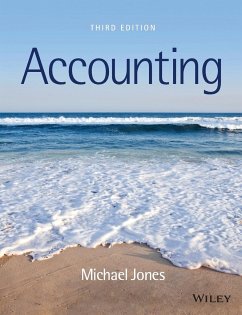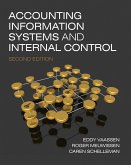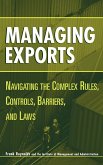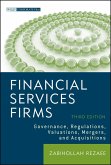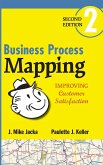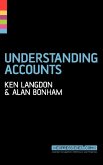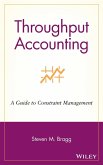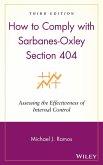Michael J. Jones
Accounting
Michael J. Jones
Accounting
- Broschiertes Buch
- Merkliste
- Auf die Merkliste
- Bewerten Bewerten
- Teilen
- Produkt teilen
- Produkterinnerung
- Produkterinnerung
We asked over 5000 accounting lecturers what would help them teach and students learn?
The results were:
Help with student engagement and varying levels of ability; Real world examples to be used in class; Content to break up lectures and engage students.
Accounting 3e has been developed to incorporate these elements and much more!
Accounting 3e provides a very accessible and easy-to-follow introduction and is aimed at students studying accounting for the first time. The book introduces concepts in an engaging and easy-to-follow manner, and examples are tried and tested with many…mehr
Andere Kunden interessierten sich auch für
![Accounting Information Systems and Internal Control Accounting Information Systems and Internal Control]() Eddy H. J. VaassenAccounting Information Systems and Internal Control74,99 €
Eddy H. J. VaassenAccounting Information Systems and Internal Control74,99 €![Managing Exports Managing Exports]() Frank ReynoldsManaging Exports153,99 €
Frank ReynoldsManaging Exports153,99 €![Financial Services Firms Financial Services Firms]() Zabihollah RezaeeFinancial Services Firms132,99 €
Zabihollah RezaeeFinancial Services Firms132,99 €![Business Process Mapping Business Process Mapping]() J. Mike JackaBusiness Process Mapping61,99 €
J. Mike JackaBusiness Process Mapping61,99 €![Understanding Accounts Understanding Accounts]() Ken LangdonUnderstanding Accounts17,99 €
Ken LangdonUnderstanding Accounts17,99 €![Throughput Accounting Throughput Accounting]() Steven M. BraggThroughput Accounting109,99 €
Steven M. BraggThroughput Accounting109,99 €![How to Comply with Sarbanes-Oxley Section 404 How to Comply with Sarbanes-Oxley Section 404]() Michael J. RamosHow to Comply with Sarbanes-Oxley Section 404116,99 €
Michael J. RamosHow to Comply with Sarbanes-Oxley Section 404116,99 €-
-
-
We asked over 5000 accounting lecturers what would help them teach and students learn?
The results were:
Help with student engagement and varying levels of ability;
Real world examples to be used in class;
Content to break up lectures and engage students.
Accounting 3e has been developed to incorporate these elements and much more!
Accounting 3e provides a very accessible and easy-to-follow introduction and is aimed at students studying accounting for the first time. The book introduces concepts in an engaging and easy-to-follow manner, and examples are tried and tested with many graded questions and answers.
The third edition is updated to reflect IFRS terminologies and format including the reorganisation of the UK standards committee in July 2012. Double entry bookkeeping is included, however, this can be bypassed for students not requiring this.
Hinweis: Dieser Artikel kann nur an eine deutsche Lieferadresse ausgeliefert werden.
The results were:
Help with student engagement and varying levels of ability;
Real world examples to be used in class;
Content to break up lectures and engage students.
Accounting 3e has been developed to incorporate these elements and much more!
Accounting 3e provides a very accessible and easy-to-follow introduction and is aimed at students studying accounting for the first time. The book introduces concepts in an engaging and easy-to-follow manner, and examples are tried and tested with many graded questions and answers.
The third edition is updated to reflect IFRS terminologies and format including the reorganisation of the UK standards committee in July 2012. Double entry bookkeeping is included, however, this can be bypassed for students not requiring this.
Hinweis: Dieser Artikel kann nur an eine deutsche Lieferadresse ausgeliefert werden.
Produktdetails
- Produktdetails
- Verlag: Wiley & Sons
- Artikelnr. des Verlages: 1W119977180
- 3. Aufl.
- Seitenzahl: 768
- Erscheinungstermin: 5. April 2013
- Englisch
- Abmessung: 246mm x 189mm x 41mm
- Gewicht: 1445g
- ISBN-13: 9781119977186
- ISBN-10: 1119977185
- Artikelnr.: 36519659
- Herstellerkennzeichnung
- Libri GmbH
- Europaallee 1
- 36244 Bad Hersfeld
- gpsr@libri.de
- Verlag: Wiley & Sons
- Artikelnr. des Verlages: 1W119977180
- 3. Aufl.
- Seitenzahl: 768
- Erscheinungstermin: 5. April 2013
- Englisch
- Abmessung: 246mm x 189mm x 41mm
- Gewicht: 1445g
- ISBN-13: 9781119977186
- ISBN-10: 1119977185
- Artikelnr.: 36519659
- Herstellerkennzeichnung
- Libri GmbH
- Europaallee 1
- 36244 Bad Hersfeld
- gpsr@libri.de
Michael Jones is Professor of Financial Reporting and Director of the Financial Reporting and Business Communication Unit at the University of Bristol, and also author of Financial Accounting, Management Accounting, and Creative Accounting, Fraud, and International Accounting Scandals, also published by John Wiley & Sons, Ltd.
About the Author xv
About the Book xvii
Acknowledgements xxiii
1 INTRODUCTION TO ACCOUNTING 1
Introduction 2
Nature of Accounting 2
Importance of Accounting 4
Financial Accounting and Management Accounting 5
Users of Accounts 6
Accounting Context 8
Types of Accountancy 12
Types of Accountant 17
Limitations of Accounting 20
Conclusion 20
Discussion Questions 22
SECTION A: FINANCIAL ACCOUNTING: THE TECHNIQUES 23
2 THE ACCOUNTING BACKGROUND 25
Introduction 26
Financial Accounting 26
Language of Accounting 28
Student Example 36
Why Is Financial Accounting Important? 40
Accounting Principles 40
Accounting Conventions 41
Conclusion 43
Discussion Questions 44
Numerical Questions 45
Appendix 2.1: Illustration of a Consolidated Income Statement for Marks &
Spencer plc 2010 46
Appendix 2.2: Illustration of a Consolidated Statement of Financial
Position for Marks and Spencer plc 2010 48
Appendix 2.3: Illustration of a Consolidated Statement of Cash Flows for
Marks and Spencer 2010 50
Appendix 2.4: Illustration of a Consolidated Income Statement for
Volkswagen 2009 52
Appendix 2.5: Illustration of a Consolidated Balance Sheet (Statement of
Financial Position) for Volkswagen 2009 53
Appendix 2.6: Illustration of a Consolidated Cash Flow Statement (Statement
of Cash Flows) for Volkswagen 2009 55
3 RECORDING: DOUBLE-ENTRY BOOKKEEPING 57
Introduction 58
The Accounting Equation 59
Worked Example 64
Computers 76
Conclusion 76
Discussion Questions 77
Numerical Questions 77
4 MAIN FINANCIAL STATEMENTS: THE INCOME STATEMENT (PROFIT AND LOSS ACCOUNT)
83
Introduction 84
Context 84
Defi nitions 86
Layout 88
Main Components 89
Profi t 97
Listed Companies 100
Capital and Revenue Expenditure 100
Limitations 101
Interpretation 101
Conclusion 101
Discussion Questions 102
Numerical Questions 102
5 MAIN FINANCIAL STATEMENTS: THE STATEMENT OF FINANCIAL POSITION (BALANCE
SHEET) 104
Introduction 105
Context 106
Definitions 107
Layout 108
Main Components 110
Limitations 121
Interpretation 122
Listed Companies 123
Conclusion 123
Discussion Questions 124
Numerical Questions 125
Appendix 5.1: Horizontal Format of Statement of Financial Position 126
6 PREPARING THE FINANCIAL STATEMENTS 127
Introduction 128
Main Financial Statements 128
Trial Balance to the Income Statement (Profi t and Loss Account) and the
Statement of Financial Position (Balance Sheet) 130
Adjustments to Trial Balance 134
Comprehensive Example 142
Conclusion 146
Discussion Questions 146
Numerical Questions 147
7 PARTNERSHIPS AND LIMITED COMPANIES 159
Introduction 160
Context 161
Partnerships 162
Limited Companies 168
Distinctive Accounting Features of Limited Companies 172
Accounting Treatment For Limited Companies 181
Limited Company Example: Stevens, Turner Ltd 183
Limited Companies: Published Accounts 188
Conclusion 193
Discussion Questions 194
Numerical Questions 195
Appendix 7.1: Example of an Income Statement (Profit and Loss Account)
using UK GAAP (Manchester United Ltd) 205
Appendix 7.2: Example of a Statement of Financial Position (Balance Sheet)
using UK GAAP (Manchester United Ltd) 206
8 MAIN FINANCIAL STATEMENT: THE STATEMENT OF CASH FLOWS 208
Introduction 209
Importance of Cash 210
Context 212
Cash and the Bank Account 212
Relationship between Cash and Profi t 216
Preparation of Statement of Cash Flows 218
Conclusion 232
Discussion Questions 232
Numerical Questions 233
Appendix 8.1: Main Headings for the Cash Flow Statement (Statement of Cash
Flows) for Sole Traders, Partnerships and some Non-Listed Companies under
UK GAAP 240
Appendix 8.2: Preparation of a Sole Trader's Cash Flow Statement Using the
Direct Method Using UK Format 241
Appendix 8.3: Preparation of the Cash Flow Statement of Any Company Ltd
using the Indirect Method Using UK GAAP 242
Appendix 8.4: Example of Statement of Cash Flow (Cash Flow Statement) Using
UK GAAP (Manchester United Ltd) 245
9 INTERPRETATION OF ACCOUNTS 247
Introduction 248
Context 248
Overview 249
Importance of Ratios 251
Closer Look at Main Ratios 252
Worked Example 264
Report Format 272
Holistic View of Ratios 274
Performance Indicators 275
Limitations 276
Conclusion 277
Discussion Questions 278
Numerical Questions 279
Appendix 9.1: John Brown Plc 288
Appendix 9.2: The Cash Flows Ratio using UK GAAP 290
SECTION B: FINANCIAL ACCOUNTING: THE CONTEXT 291
10 REGULATORY AND CONCEPTUAL FRAMEWORKS 293
Introduction 294
Traditional Corporate Model: Directors, Auditors and Shareholders 295
Regulatory Framework 300
Regulatory Framework in the UK 302
Corporate Governance 307
Conceptual Framework 311
Conclusion 319
Selected Reading 320
Discussion Questions 321
11 MEASUREMENT SYSTEMS 322
Introduction 323
Overview 323
Measurement Systems 326
Deficiencies of Historical Cost Accounting 328
Illustrative Example of Different Measurement Systems 328
Real Life 331
Conclusion 332
Selected Reading 332
Discussion Questions 333
12 THE ANNUAL REPORT 334
Introduction 335
Definition 335
Context 336
Multiple Roles 337
Main Contents of the Annual Report 342
Presentation 359
Group Accounts 361
Impression Management 365
Conclusion 368
Selected Reading 369
Discussion Questions 370
13 CREATIVE ACCOUNTING 371
Introduction 372
Defi nition 374
Managerial Motivation 376
Methods of Creative Accounting 378
Example 385
Real Life 385
Case Studies 388
Creative Presentation 392
Controlling Creative Accounting 394
Conclusion 394
Selected Reading 395
Discussion Questions 396
14 INTERNATIONAL ACCOUNTING 398
Introduction 399
Context 399
Divergent Forces 401
Classification 407
Country Snapshots 407
Convergent Forces 414
Conclusion 420
Selected Reading 420
Discussion Questions 421
Appendix 14.1: List of International Standards 422
SECTION C: MANAGEMENT ACCOUNTING 425
15 INTRODUCTION TO MANAGEMENT ACCOUNTING 427
Introduction 428
Context 429
Relationship with Financial Accounting 430
Overview 432
Cost Minimisation and Revenue Maximisation 439
Use of Computers and Impact of Digital Technology 441
Art not a Science 442
Changing Nature of Management Accounting 442
Conclusion 442
Selected Reading 443
Discussion Questions 444
16 COSTING 445
Introduction 446
Importance of Cost Accounting 447
Types of Cost 448
Traditional Costing 452
Activity-Based Costing 458
Costing for Inventory Valuation 462
Different Costing Methods for Different Industries 466
Target Costing 470
Cost-Cutting 470
Conclusion 471
Discussion Questions 472
Numerical Questions 472
17 PLANNING, CONTROL AND PERFORMANCE: BUDGETING 478
Introduction 479
Management Accounting Control Systems 479
Nature of Budgeting 480
Cash Budget 484
Other Budgets 485
Manufacturing Budgets 488
Comprehensive Budgeting Example 491
Behavioural Aspects of Budgeting 496
Responsibility Accounting 500
Conclusion 502
Discussion Questions 502
Numerical Questions 503
18 PLANNING, CONTROL AND PERFORMANCE: STANDARD COSTING 508
Introduction 509
Nature of Standard Costing 510
Standard Cost Variances 511
Interpretation of Variances 520
Conclusion 521
Discussion Questions 522
Numerical Questions 523
19 SHORT-TERM DECISION MAKING 527
Introduction 528
Decision Making 528
Contribution Analysis 530
Decisions, Decisions 534
Throughput Accounting 540
Break-Even Analysis 542
Contribution Graph 546
Conclusion 548
Discussion Questions 549
Numerical Questions 549
20 STRATEGIC MANAGEMENT ACCOUNTING 554
Introduction 555
Nature of Strategic Management Accounting 557
Assessment of Current Position of the Business 559
Appraisal of Current Position of the Business 568
Strategic Choice of Future Direction 573
Conclusion 576
Selected Reading 576
Discussion Questions 577
Numerical Questions 578
21 LONG-TERM DECISION MAKING: CAPITAL INVESTMENT APPRAISAL 581
Introduction 582
Nature of Capital Investment 582
Capital Investment Appraisal Techniques 586
Payback Period 588
Accounting Rate of Return 590
Net Present Value 592
Profi tability Index 595
Internal Rate of Return (IRR) 595
Other Factors 600
Conclusion 600
Discussion Questions 601
Numerical Questions 602
Appendix 21.1: Present Value of £1 at Compound Interest Rate (1 r) 605
22 THE MANAGEMENT OF WORKING CAPITAL AND SOURCES OF FINANCE 606
Introduction 607
Nature of Sources of Finance 607
Short-Term Financing 608
Long-Term Financing 618
Cost of Capital 623
Conclusion 626
Discussion Questions 627
Numerical Questions 628
Glossary of Key Accounting Terms 631
Appendix: Answers 663
Index 723
About the Book xvii
Acknowledgements xxiii
1 INTRODUCTION TO ACCOUNTING 1
Introduction 2
Nature of Accounting 2
Importance of Accounting 4
Financial Accounting and Management Accounting 5
Users of Accounts 6
Accounting Context 8
Types of Accountancy 12
Types of Accountant 17
Limitations of Accounting 20
Conclusion 20
Discussion Questions 22
SECTION A: FINANCIAL ACCOUNTING: THE TECHNIQUES 23
2 THE ACCOUNTING BACKGROUND 25
Introduction 26
Financial Accounting 26
Language of Accounting 28
Student Example 36
Why Is Financial Accounting Important? 40
Accounting Principles 40
Accounting Conventions 41
Conclusion 43
Discussion Questions 44
Numerical Questions 45
Appendix 2.1: Illustration of a Consolidated Income Statement for Marks &
Spencer plc 2010 46
Appendix 2.2: Illustration of a Consolidated Statement of Financial
Position for Marks and Spencer plc 2010 48
Appendix 2.3: Illustration of a Consolidated Statement of Cash Flows for
Marks and Spencer 2010 50
Appendix 2.4: Illustration of a Consolidated Income Statement for
Volkswagen 2009 52
Appendix 2.5: Illustration of a Consolidated Balance Sheet (Statement of
Financial Position) for Volkswagen 2009 53
Appendix 2.6: Illustration of a Consolidated Cash Flow Statement (Statement
of Cash Flows) for Volkswagen 2009 55
3 RECORDING: DOUBLE-ENTRY BOOKKEEPING 57
Introduction 58
The Accounting Equation 59
Worked Example 64
Computers 76
Conclusion 76
Discussion Questions 77
Numerical Questions 77
4 MAIN FINANCIAL STATEMENTS: THE INCOME STATEMENT (PROFIT AND LOSS ACCOUNT)
83
Introduction 84
Context 84
Defi nitions 86
Layout 88
Main Components 89
Profi t 97
Listed Companies 100
Capital and Revenue Expenditure 100
Limitations 101
Interpretation 101
Conclusion 101
Discussion Questions 102
Numerical Questions 102
5 MAIN FINANCIAL STATEMENTS: THE STATEMENT OF FINANCIAL POSITION (BALANCE
SHEET) 104
Introduction 105
Context 106
Definitions 107
Layout 108
Main Components 110
Limitations 121
Interpretation 122
Listed Companies 123
Conclusion 123
Discussion Questions 124
Numerical Questions 125
Appendix 5.1: Horizontal Format of Statement of Financial Position 126
6 PREPARING THE FINANCIAL STATEMENTS 127
Introduction 128
Main Financial Statements 128
Trial Balance to the Income Statement (Profi t and Loss Account) and the
Statement of Financial Position (Balance Sheet) 130
Adjustments to Trial Balance 134
Comprehensive Example 142
Conclusion 146
Discussion Questions 146
Numerical Questions 147
7 PARTNERSHIPS AND LIMITED COMPANIES 159
Introduction 160
Context 161
Partnerships 162
Limited Companies 168
Distinctive Accounting Features of Limited Companies 172
Accounting Treatment For Limited Companies 181
Limited Company Example: Stevens, Turner Ltd 183
Limited Companies: Published Accounts 188
Conclusion 193
Discussion Questions 194
Numerical Questions 195
Appendix 7.1: Example of an Income Statement (Profit and Loss Account)
using UK GAAP (Manchester United Ltd) 205
Appendix 7.2: Example of a Statement of Financial Position (Balance Sheet)
using UK GAAP (Manchester United Ltd) 206
8 MAIN FINANCIAL STATEMENT: THE STATEMENT OF CASH FLOWS 208
Introduction 209
Importance of Cash 210
Context 212
Cash and the Bank Account 212
Relationship between Cash and Profi t 216
Preparation of Statement of Cash Flows 218
Conclusion 232
Discussion Questions 232
Numerical Questions 233
Appendix 8.1: Main Headings for the Cash Flow Statement (Statement of Cash
Flows) for Sole Traders, Partnerships and some Non-Listed Companies under
UK GAAP 240
Appendix 8.2: Preparation of a Sole Trader's Cash Flow Statement Using the
Direct Method Using UK Format 241
Appendix 8.3: Preparation of the Cash Flow Statement of Any Company Ltd
using the Indirect Method Using UK GAAP 242
Appendix 8.4: Example of Statement of Cash Flow (Cash Flow Statement) Using
UK GAAP (Manchester United Ltd) 245
9 INTERPRETATION OF ACCOUNTS 247
Introduction 248
Context 248
Overview 249
Importance of Ratios 251
Closer Look at Main Ratios 252
Worked Example 264
Report Format 272
Holistic View of Ratios 274
Performance Indicators 275
Limitations 276
Conclusion 277
Discussion Questions 278
Numerical Questions 279
Appendix 9.1: John Brown Plc 288
Appendix 9.2: The Cash Flows Ratio using UK GAAP 290
SECTION B: FINANCIAL ACCOUNTING: THE CONTEXT 291
10 REGULATORY AND CONCEPTUAL FRAMEWORKS 293
Introduction 294
Traditional Corporate Model: Directors, Auditors and Shareholders 295
Regulatory Framework 300
Regulatory Framework in the UK 302
Corporate Governance 307
Conceptual Framework 311
Conclusion 319
Selected Reading 320
Discussion Questions 321
11 MEASUREMENT SYSTEMS 322
Introduction 323
Overview 323
Measurement Systems 326
Deficiencies of Historical Cost Accounting 328
Illustrative Example of Different Measurement Systems 328
Real Life 331
Conclusion 332
Selected Reading 332
Discussion Questions 333
12 THE ANNUAL REPORT 334
Introduction 335
Definition 335
Context 336
Multiple Roles 337
Main Contents of the Annual Report 342
Presentation 359
Group Accounts 361
Impression Management 365
Conclusion 368
Selected Reading 369
Discussion Questions 370
13 CREATIVE ACCOUNTING 371
Introduction 372
Defi nition 374
Managerial Motivation 376
Methods of Creative Accounting 378
Example 385
Real Life 385
Case Studies 388
Creative Presentation 392
Controlling Creative Accounting 394
Conclusion 394
Selected Reading 395
Discussion Questions 396
14 INTERNATIONAL ACCOUNTING 398
Introduction 399
Context 399
Divergent Forces 401
Classification 407
Country Snapshots 407
Convergent Forces 414
Conclusion 420
Selected Reading 420
Discussion Questions 421
Appendix 14.1: List of International Standards 422
SECTION C: MANAGEMENT ACCOUNTING 425
15 INTRODUCTION TO MANAGEMENT ACCOUNTING 427
Introduction 428
Context 429
Relationship with Financial Accounting 430
Overview 432
Cost Minimisation and Revenue Maximisation 439
Use of Computers and Impact of Digital Technology 441
Art not a Science 442
Changing Nature of Management Accounting 442
Conclusion 442
Selected Reading 443
Discussion Questions 444
16 COSTING 445
Introduction 446
Importance of Cost Accounting 447
Types of Cost 448
Traditional Costing 452
Activity-Based Costing 458
Costing for Inventory Valuation 462
Different Costing Methods for Different Industries 466
Target Costing 470
Cost-Cutting 470
Conclusion 471
Discussion Questions 472
Numerical Questions 472
17 PLANNING, CONTROL AND PERFORMANCE: BUDGETING 478
Introduction 479
Management Accounting Control Systems 479
Nature of Budgeting 480
Cash Budget 484
Other Budgets 485
Manufacturing Budgets 488
Comprehensive Budgeting Example 491
Behavioural Aspects of Budgeting 496
Responsibility Accounting 500
Conclusion 502
Discussion Questions 502
Numerical Questions 503
18 PLANNING, CONTROL AND PERFORMANCE: STANDARD COSTING 508
Introduction 509
Nature of Standard Costing 510
Standard Cost Variances 511
Interpretation of Variances 520
Conclusion 521
Discussion Questions 522
Numerical Questions 523
19 SHORT-TERM DECISION MAKING 527
Introduction 528
Decision Making 528
Contribution Analysis 530
Decisions, Decisions 534
Throughput Accounting 540
Break-Even Analysis 542
Contribution Graph 546
Conclusion 548
Discussion Questions 549
Numerical Questions 549
20 STRATEGIC MANAGEMENT ACCOUNTING 554
Introduction 555
Nature of Strategic Management Accounting 557
Assessment of Current Position of the Business 559
Appraisal of Current Position of the Business 568
Strategic Choice of Future Direction 573
Conclusion 576
Selected Reading 576
Discussion Questions 577
Numerical Questions 578
21 LONG-TERM DECISION MAKING: CAPITAL INVESTMENT APPRAISAL 581
Introduction 582
Nature of Capital Investment 582
Capital Investment Appraisal Techniques 586
Payback Period 588
Accounting Rate of Return 590
Net Present Value 592
Profi tability Index 595
Internal Rate of Return (IRR) 595
Other Factors 600
Conclusion 600
Discussion Questions 601
Numerical Questions 602
Appendix 21.1: Present Value of £1 at Compound Interest Rate (1 r) 605
22 THE MANAGEMENT OF WORKING CAPITAL AND SOURCES OF FINANCE 606
Introduction 607
Nature of Sources of Finance 607
Short-Term Financing 608
Long-Term Financing 618
Cost of Capital 623
Conclusion 626
Discussion Questions 627
Numerical Questions 628
Glossary of Key Accounting Terms 631
Appendix: Answers 663
Index 723
About the Author xv
About the Book xvii
Acknowledgements xxiii
1 INTRODUCTION TO ACCOUNTING 1
Introduction 2
Nature of Accounting 2
Importance of Accounting 4
Financial Accounting and Management Accounting 5
Users of Accounts 6
Accounting Context 8
Types of Accountancy 12
Types of Accountant 17
Limitations of Accounting 20
Conclusion 20
Discussion Questions 22
SECTION A: FINANCIAL ACCOUNTING: THE TECHNIQUES 23
2 THE ACCOUNTING BACKGROUND 25
Introduction 26
Financial Accounting 26
Language of Accounting 28
Student Example 36
Why Is Financial Accounting Important? 40
Accounting Principles 40
Accounting Conventions 41
Conclusion 43
Discussion Questions 44
Numerical Questions 45
Appendix 2.1: Illustration of a Consolidated Income Statement for Marks &
Spencer plc 2010 46
Appendix 2.2: Illustration of a Consolidated Statement of Financial
Position for Marks and Spencer plc 2010 48
Appendix 2.3: Illustration of a Consolidated Statement of Cash Flows for
Marks and Spencer 2010 50
Appendix 2.4: Illustration of a Consolidated Income Statement for
Volkswagen 2009 52
Appendix 2.5: Illustration of a Consolidated Balance Sheet (Statement of
Financial Position) for Volkswagen 2009 53
Appendix 2.6: Illustration of a Consolidated Cash Flow Statement (Statement
of Cash Flows) for Volkswagen 2009 55
3 RECORDING: DOUBLE-ENTRY BOOKKEEPING 57
Introduction 58
The Accounting Equation 59
Worked Example 64
Computers 76
Conclusion 76
Discussion Questions 77
Numerical Questions 77
4 MAIN FINANCIAL STATEMENTS: THE INCOME STATEMENT (PROFIT AND LOSS ACCOUNT)
83
Introduction 84
Context 84
Defi nitions 86
Layout 88
Main Components 89
Profi t 97
Listed Companies 100
Capital and Revenue Expenditure 100
Limitations 101
Interpretation 101
Conclusion 101
Discussion Questions 102
Numerical Questions 102
5 MAIN FINANCIAL STATEMENTS: THE STATEMENT OF FINANCIAL POSITION (BALANCE
SHEET) 104
Introduction 105
Context 106
Definitions 107
Layout 108
Main Components 110
Limitations 121
Interpretation 122
Listed Companies 123
Conclusion 123
Discussion Questions 124
Numerical Questions 125
Appendix 5.1: Horizontal Format of Statement of Financial Position 126
6 PREPARING THE FINANCIAL STATEMENTS 127
Introduction 128
Main Financial Statements 128
Trial Balance to the Income Statement (Profi t and Loss Account) and the
Statement of Financial Position (Balance Sheet) 130
Adjustments to Trial Balance 134
Comprehensive Example 142
Conclusion 146
Discussion Questions 146
Numerical Questions 147
7 PARTNERSHIPS AND LIMITED COMPANIES 159
Introduction 160
Context 161
Partnerships 162
Limited Companies 168
Distinctive Accounting Features of Limited Companies 172
Accounting Treatment For Limited Companies 181
Limited Company Example: Stevens, Turner Ltd 183
Limited Companies: Published Accounts 188
Conclusion 193
Discussion Questions 194
Numerical Questions 195
Appendix 7.1: Example of an Income Statement (Profit and Loss Account)
using UK GAAP (Manchester United Ltd) 205
Appendix 7.2: Example of a Statement of Financial Position (Balance Sheet)
using UK GAAP (Manchester United Ltd) 206
8 MAIN FINANCIAL STATEMENT: THE STATEMENT OF CASH FLOWS 208
Introduction 209
Importance of Cash 210
Context 212
Cash and the Bank Account 212
Relationship between Cash and Profi t 216
Preparation of Statement of Cash Flows 218
Conclusion 232
Discussion Questions 232
Numerical Questions 233
Appendix 8.1: Main Headings for the Cash Flow Statement (Statement of Cash
Flows) for Sole Traders, Partnerships and some Non-Listed Companies under
UK GAAP 240
Appendix 8.2: Preparation of a Sole Trader's Cash Flow Statement Using the
Direct Method Using UK Format 241
Appendix 8.3: Preparation of the Cash Flow Statement of Any Company Ltd
using the Indirect Method Using UK GAAP 242
Appendix 8.4: Example of Statement of Cash Flow (Cash Flow Statement) Using
UK GAAP (Manchester United Ltd) 245
9 INTERPRETATION OF ACCOUNTS 247
Introduction 248
Context 248
Overview 249
Importance of Ratios 251
Closer Look at Main Ratios 252
Worked Example 264
Report Format 272
Holistic View of Ratios 274
Performance Indicators 275
Limitations 276
Conclusion 277
Discussion Questions 278
Numerical Questions 279
Appendix 9.1: John Brown Plc 288
Appendix 9.2: The Cash Flows Ratio using UK GAAP 290
SECTION B: FINANCIAL ACCOUNTING: THE CONTEXT 291
10 REGULATORY AND CONCEPTUAL FRAMEWORKS 293
Introduction 294
Traditional Corporate Model: Directors, Auditors and Shareholders 295
Regulatory Framework 300
Regulatory Framework in the UK 302
Corporate Governance 307
Conceptual Framework 311
Conclusion 319
Selected Reading 320
Discussion Questions 321
11 MEASUREMENT SYSTEMS 322
Introduction 323
Overview 323
Measurement Systems 326
Deficiencies of Historical Cost Accounting 328
Illustrative Example of Different Measurement Systems 328
Real Life 331
Conclusion 332
Selected Reading 332
Discussion Questions 333
12 THE ANNUAL REPORT 334
Introduction 335
Definition 335
Context 336
Multiple Roles 337
Main Contents of the Annual Report 342
Presentation 359
Group Accounts 361
Impression Management 365
Conclusion 368
Selected Reading 369
Discussion Questions 370
13 CREATIVE ACCOUNTING 371
Introduction 372
Defi nition 374
Managerial Motivation 376
Methods of Creative Accounting 378
Example 385
Real Life 385
Case Studies 388
Creative Presentation 392
Controlling Creative Accounting 394
Conclusion 394
Selected Reading 395
Discussion Questions 396
14 INTERNATIONAL ACCOUNTING 398
Introduction 399
Context 399
Divergent Forces 401
Classification 407
Country Snapshots 407
Convergent Forces 414
Conclusion 420
Selected Reading 420
Discussion Questions 421
Appendix 14.1: List of International Standards 422
SECTION C: MANAGEMENT ACCOUNTING 425
15 INTRODUCTION TO MANAGEMENT ACCOUNTING 427
Introduction 428
Context 429
Relationship with Financial Accounting 430
Overview 432
Cost Minimisation and Revenue Maximisation 439
Use of Computers and Impact of Digital Technology 441
Art not a Science 442
Changing Nature of Management Accounting 442
Conclusion 442
Selected Reading 443
Discussion Questions 444
16 COSTING 445
Introduction 446
Importance of Cost Accounting 447
Types of Cost 448
Traditional Costing 452
Activity-Based Costing 458
Costing for Inventory Valuation 462
Different Costing Methods for Different Industries 466
Target Costing 470
Cost-Cutting 470
Conclusion 471
Discussion Questions 472
Numerical Questions 472
17 PLANNING, CONTROL AND PERFORMANCE: BUDGETING 478
Introduction 479
Management Accounting Control Systems 479
Nature of Budgeting 480
Cash Budget 484
Other Budgets 485
Manufacturing Budgets 488
Comprehensive Budgeting Example 491
Behavioural Aspects of Budgeting 496
Responsibility Accounting 500
Conclusion 502
Discussion Questions 502
Numerical Questions 503
18 PLANNING, CONTROL AND PERFORMANCE: STANDARD COSTING 508
Introduction 509
Nature of Standard Costing 510
Standard Cost Variances 511
Interpretation of Variances 520
Conclusion 521
Discussion Questions 522
Numerical Questions 523
19 SHORT-TERM DECISION MAKING 527
Introduction 528
Decision Making 528
Contribution Analysis 530
Decisions, Decisions 534
Throughput Accounting 540
Break-Even Analysis 542
Contribution Graph 546
Conclusion 548
Discussion Questions 549
Numerical Questions 549
20 STRATEGIC MANAGEMENT ACCOUNTING 554
Introduction 555
Nature of Strategic Management Accounting 557
Assessment of Current Position of the Business 559
Appraisal of Current Position of the Business 568
Strategic Choice of Future Direction 573
Conclusion 576
Selected Reading 576
Discussion Questions 577
Numerical Questions 578
21 LONG-TERM DECISION MAKING: CAPITAL INVESTMENT APPRAISAL 581
Introduction 582
Nature of Capital Investment 582
Capital Investment Appraisal Techniques 586
Payback Period 588
Accounting Rate of Return 590
Net Present Value 592
Profi tability Index 595
Internal Rate of Return (IRR) 595
Other Factors 600
Conclusion 600
Discussion Questions 601
Numerical Questions 602
Appendix 21.1: Present Value of £1 at Compound Interest Rate (1 r) 605
22 THE MANAGEMENT OF WORKING CAPITAL AND SOURCES OF FINANCE 606
Introduction 607
Nature of Sources of Finance 607
Short-Term Financing 608
Long-Term Financing 618
Cost of Capital 623
Conclusion 626
Discussion Questions 627
Numerical Questions 628
Glossary of Key Accounting Terms 631
Appendix: Answers 663
Index 723
About the Book xvii
Acknowledgements xxiii
1 INTRODUCTION TO ACCOUNTING 1
Introduction 2
Nature of Accounting 2
Importance of Accounting 4
Financial Accounting and Management Accounting 5
Users of Accounts 6
Accounting Context 8
Types of Accountancy 12
Types of Accountant 17
Limitations of Accounting 20
Conclusion 20
Discussion Questions 22
SECTION A: FINANCIAL ACCOUNTING: THE TECHNIQUES 23
2 THE ACCOUNTING BACKGROUND 25
Introduction 26
Financial Accounting 26
Language of Accounting 28
Student Example 36
Why Is Financial Accounting Important? 40
Accounting Principles 40
Accounting Conventions 41
Conclusion 43
Discussion Questions 44
Numerical Questions 45
Appendix 2.1: Illustration of a Consolidated Income Statement for Marks &
Spencer plc 2010 46
Appendix 2.2: Illustration of a Consolidated Statement of Financial
Position for Marks and Spencer plc 2010 48
Appendix 2.3: Illustration of a Consolidated Statement of Cash Flows for
Marks and Spencer 2010 50
Appendix 2.4: Illustration of a Consolidated Income Statement for
Volkswagen 2009 52
Appendix 2.5: Illustration of a Consolidated Balance Sheet (Statement of
Financial Position) for Volkswagen 2009 53
Appendix 2.6: Illustration of a Consolidated Cash Flow Statement (Statement
of Cash Flows) for Volkswagen 2009 55
3 RECORDING: DOUBLE-ENTRY BOOKKEEPING 57
Introduction 58
The Accounting Equation 59
Worked Example 64
Computers 76
Conclusion 76
Discussion Questions 77
Numerical Questions 77
4 MAIN FINANCIAL STATEMENTS: THE INCOME STATEMENT (PROFIT AND LOSS ACCOUNT)
83
Introduction 84
Context 84
Defi nitions 86
Layout 88
Main Components 89
Profi t 97
Listed Companies 100
Capital and Revenue Expenditure 100
Limitations 101
Interpretation 101
Conclusion 101
Discussion Questions 102
Numerical Questions 102
5 MAIN FINANCIAL STATEMENTS: THE STATEMENT OF FINANCIAL POSITION (BALANCE
SHEET) 104
Introduction 105
Context 106
Definitions 107
Layout 108
Main Components 110
Limitations 121
Interpretation 122
Listed Companies 123
Conclusion 123
Discussion Questions 124
Numerical Questions 125
Appendix 5.1: Horizontal Format of Statement of Financial Position 126
6 PREPARING THE FINANCIAL STATEMENTS 127
Introduction 128
Main Financial Statements 128
Trial Balance to the Income Statement (Profi t and Loss Account) and the
Statement of Financial Position (Balance Sheet) 130
Adjustments to Trial Balance 134
Comprehensive Example 142
Conclusion 146
Discussion Questions 146
Numerical Questions 147
7 PARTNERSHIPS AND LIMITED COMPANIES 159
Introduction 160
Context 161
Partnerships 162
Limited Companies 168
Distinctive Accounting Features of Limited Companies 172
Accounting Treatment For Limited Companies 181
Limited Company Example: Stevens, Turner Ltd 183
Limited Companies: Published Accounts 188
Conclusion 193
Discussion Questions 194
Numerical Questions 195
Appendix 7.1: Example of an Income Statement (Profit and Loss Account)
using UK GAAP (Manchester United Ltd) 205
Appendix 7.2: Example of a Statement of Financial Position (Balance Sheet)
using UK GAAP (Manchester United Ltd) 206
8 MAIN FINANCIAL STATEMENT: THE STATEMENT OF CASH FLOWS 208
Introduction 209
Importance of Cash 210
Context 212
Cash and the Bank Account 212
Relationship between Cash and Profi t 216
Preparation of Statement of Cash Flows 218
Conclusion 232
Discussion Questions 232
Numerical Questions 233
Appendix 8.1: Main Headings for the Cash Flow Statement (Statement of Cash
Flows) for Sole Traders, Partnerships and some Non-Listed Companies under
UK GAAP 240
Appendix 8.2: Preparation of a Sole Trader's Cash Flow Statement Using the
Direct Method Using UK Format 241
Appendix 8.3: Preparation of the Cash Flow Statement of Any Company Ltd
using the Indirect Method Using UK GAAP 242
Appendix 8.4: Example of Statement of Cash Flow (Cash Flow Statement) Using
UK GAAP (Manchester United Ltd) 245
9 INTERPRETATION OF ACCOUNTS 247
Introduction 248
Context 248
Overview 249
Importance of Ratios 251
Closer Look at Main Ratios 252
Worked Example 264
Report Format 272
Holistic View of Ratios 274
Performance Indicators 275
Limitations 276
Conclusion 277
Discussion Questions 278
Numerical Questions 279
Appendix 9.1: John Brown Plc 288
Appendix 9.2: The Cash Flows Ratio using UK GAAP 290
SECTION B: FINANCIAL ACCOUNTING: THE CONTEXT 291
10 REGULATORY AND CONCEPTUAL FRAMEWORKS 293
Introduction 294
Traditional Corporate Model: Directors, Auditors and Shareholders 295
Regulatory Framework 300
Regulatory Framework in the UK 302
Corporate Governance 307
Conceptual Framework 311
Conclusion 319
Selected Reading 320
Discussion Questions 321
11 MEASUREMENT SYSTEMS 322
Introduction 323
Overview 323
Measurement Systems 326
Deficiencies of Historical Cost Accounting 328
Illustrative Example of Different Measurement Systems 328
Real Life 331
Conclusion 332
Selected Reading 332
Discussion Questions 333
12 THE ANNUAL REPORT 334
Introduction 335
Definition 335
Context 336
Multiple Roles 337
Main Contents of the Annual Report 342
Presentation 359
Group Accounts 361
Impression Management 365
Conclusion 368
Selected Reading 369
Discussion Questions 370
13 CREATIVE ACCOUNTING 371
Introduction 372
Defi nition 374
Managerial Motivation 376
Methods of Creative Accounting 378
Example 385
Real Life 385
Case Studies 388
Creative Presentation 392
Controlling Creative Accounting 394
Conclusion 394
Selected Reading 395
Discussion Questions 396
14 INTERNATIONAL ACCOUNTING 398
Introduction 399
Context 399
Divergent Forces 401
Classification 407
Country Snapshots 407
Convergent Forces 414
Conclusion 420
Selected Reading 420
Discussion Questions 421
Appendix 14.1: List of International Standards 422
SECTION C: MANAGEMENT ACCOUNTING 425
15 INTRODUCTION TO MANAGEMENT ACCOUNTING 427
Introduction 428
Context 429
Relationship with Financial Accounting 430
Overview 432
Cost Minimisation and Revenue Maximisation 439
Use of Computers and Impact of Digital Technology 441
Art not a Science 442
Changing Nature of Management Accounting 442
Conclusion 442
Selected Reading 443
Discussion Questions 444
16 COSTING 445
Introduction 446
Importance of Cost Accounting 447
Types of Cost 448
Traditional Costing 452
Activity-Based Costing 458
Costing for Inventory Valuation 462
Different Costing Methods for Different Industries 466
Target Costing 470
Cost-Cutting 470
Conclusion 471
Discussion Questions 472
Numerical Questions 472
17 PLANNING, CONTROL AND PERFORMANCE: BUDGETING 478
Introduction 479
Management Accounting Control Systems 479
Nature of Budgeting 480
Cash Budget 484
Other Budgets 485
Manufacturing Budgets 488
Comprehensive Budgeting Example 491
Behavioural Aspects of Budgeting 496
Responsibility Accounting 500
Conclusion 502
Discussion Questions 502
Numerical Questions 503
18 PLANNING, CONTROL AND PERFORMANCE: STANDARD COSTING 508
Introduction 509
Nature of Standard Costing 510
Standard Cost Variances 511
Interpretation of Variances 520
Conclusion 521
Discussion Questions 522
Numerical Questions 523
19 SHORT-TERM DECISION MAKING 527
Introduction 528
Decision Making 528
Contribution Analysis 530
Decisions, Decisions 534
Throughput Accounting 540
Break-Even Analysis 542
Contribution Graph 546
Conclusion 548
Discussion Questions 549
Numerical Questions 549
20 STRATEGIC MANAGEMENT ACCOUNTING 554
Introduction 555
Nature of Strategic Management Accounting 557
Assessment of Current Position of the Business 559
Appraisal of Current Position of the Business 568
Strategic Choice of Future Direction 573
Conclusion 576
Selected Reading 576
Discussion Questions 577
Numerical Questions 578
21 LONG-TERM DECISION MAKING: CAPITAL INVESTMENT APPRAISAL 581
Introduction 582
Nature of Capital Investment 582
Capital Investment Appraisal Techniques 586
Payback Period 588
Accounting Rate of Return 590
Net Present Value 592
Profi tability Index 595
Internal Rate of Return (IRR) 595
Other Factors 600
Conclusion 600
Discussion Questions 601
Numerical Questions 602
Appendix 21.1: Present Value of £1 at Compound Interest Rate (1 r) 605
22 THE MANAGEMENT OF WORKING CAPITAL AND SOURCES OF FINANCE 606
Introduction 607
Nature of Sources of Finance 607
Short-Term Financing 608
Long-Term Financing 618
Cost of Capital 623
Conclusion 626
Discussion Questions 627
Numerical Questions 628
Glossary of Key Accounting Terms 631
Appendix: Answers 663
Index 723

